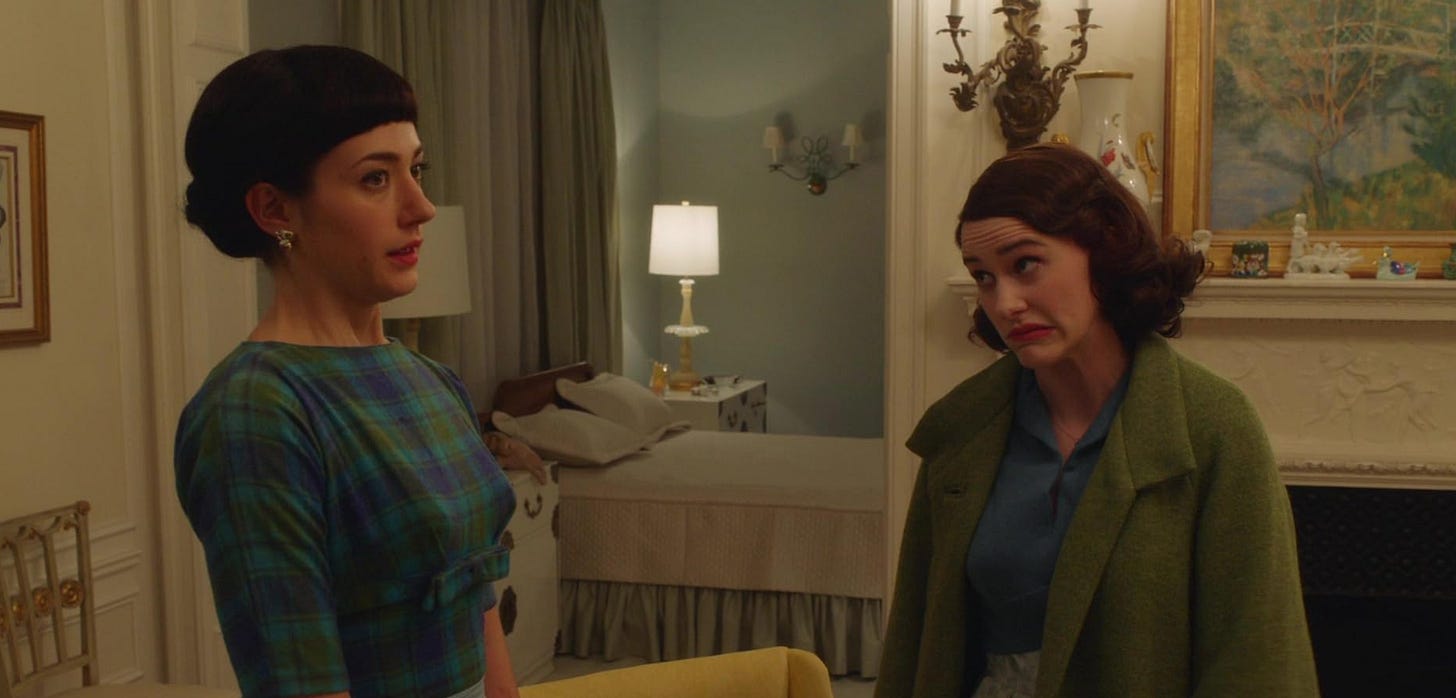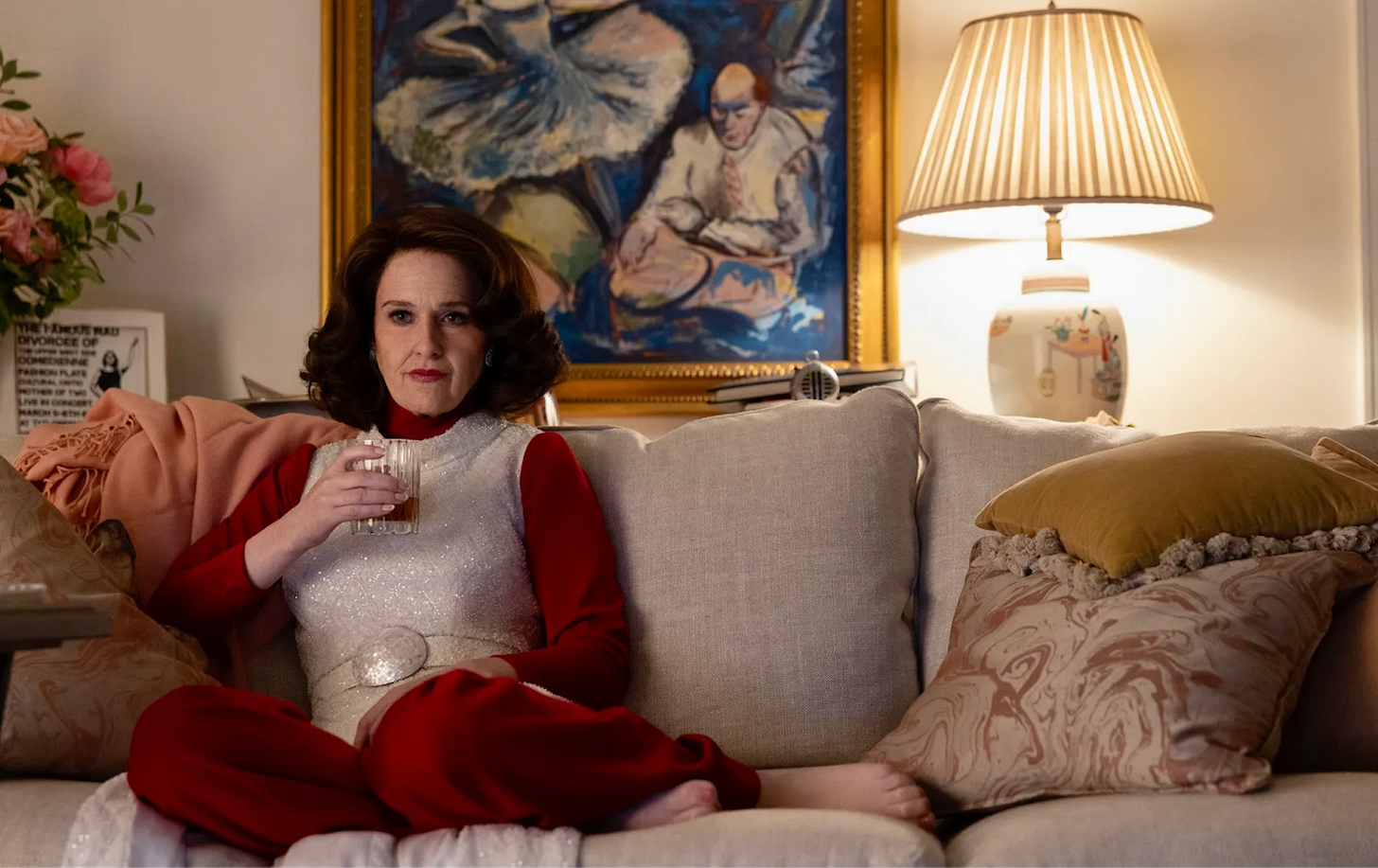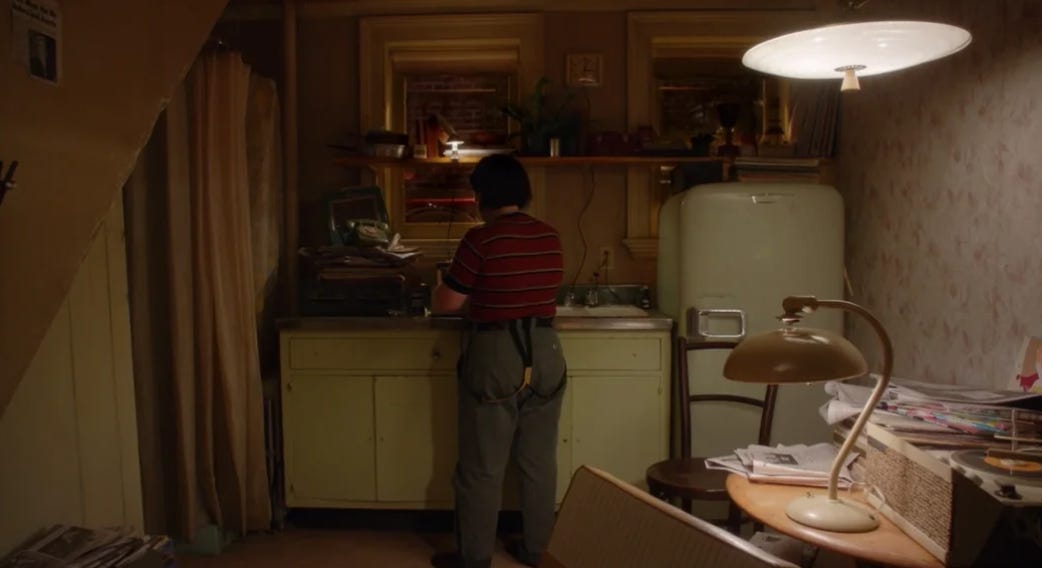Midge Maisel's journey was also about her apartment
On finding stability in New York real estate
A year ago, I nearly lost my apartment. Last spring, my husband and I received a “move out” letter from our unit owner’s lawyer. Details were slim but in the coming days, we found out that our rental, which had been under the same ownership for 40 years, would be for sale. We could still live there in the interim, but it would be on a month-to-month basis until a new owner bought it. Our apartment was nearly 100 years old, and we hadn’t even clocked a year living in it. Two weeks before, I had finally hung up all the art.
After 11 years of living in Hell’s Kitchen, we had finally found the perfect apartment: 900 square feet, large closets, and rooftop access. Plus, an easy walk to Central Park. It was the perfect spot to grow old. After a decade of shitty walk-ups, sketchy neighbors, and surviving Covid, finding this apartment felt like an unassembled puzzle finally clicking its last pieces into place. How could we say goodbye to it?
In the interim of waiting for next steps (Can they do this? Will we leave? Where will we live?) I had a lot of time to think about the idea of home, and what that could look like. I did a lot of revenge searching, looking up historic buildings on the Upper West Side, but all of Emery Roth’s buildings were financially out of reach. In my delusional StreetEasy-addicted brain, I wanted the San Remo.

And then we did it. We pooled together all our money —15 years of saving for retirement and vacations — and put in an offer, and bought our place back. It took five months of sifting through archaic 1980s contracts, agent shenanigans, negotiations over inane stuff like missing fire alarms (seriously). But it happened and I am just as surprised as anyone.
I wish I could say it was a triumphant feeling to save our apartment, but putting in an offer was the most scared I’ve been in my life. Amidst the housing crisis that has made owning and renting so untenable in this city, I do not take it for granted that I was able to do this. Buying the place felt like a long exhale, a giant ‘fuck you’ to every past landlord, every ‘so when are you moving back home?’ We are home.
On Midge Maisel’s search for home

I think about my apartment journey whenever I rewatch The Marvelous Mrs. Maisel. The show, by Amy Sherman-Palladino and Daniel Palladino, is ostensibly about one funny woman’s rise in the mid-century comedy world, but it is also a show about New York real estate. Midge (Rachel Brosnahan) finds out early in the first season that her husband Joel’s cheating means that if they break up, she will no longer have a home (her father-in-law, Moishe, owns the deed and believes in tough love). Midge is lucky – her parents live in a similar classic-six layout on another floor in the same building, and can squeeze in Midge, her children, and her hat collection. But in the rest of the series, her career runs parallel to her gaining enough financial stability to buy her old place back.
Note - some spoilers on the entire series!
Certain episodes still make me cry, like when she says goodbye to her place, and seemingly every memory made in it — from Joel carrying her over the threshold when they move in, to bringing their babies home, to their last New Year’s party. Or when she finally buys the place back in season 4, and she invites her parents to come live with her. What is a home, if not the canvas for all our selves, and our possibilities? Midge’s apartment is symbolic of that ambition.

What is Midge’s taste? I’d call it traditional, skewing feminine and French. There’s lots of florals, with pastel pinks and blues. There’s some eclectic choices in there – she’s got a Chinese screen, a modular sofa, and French pastoral lamps (which Imogene calls ‘orgy’ lamps in S4). Her living room palette in the first photo reminds me of Monet’s water lilies. After she dates Benjamin in S2, she acquires an interest in modern art, and that’s reflected on her walls when she gets her place back in S4.
You could argue there are times when Midge is a complex and difficult character to root for.1 But her journey to stability – for her career, family, and home – is deeply relatable. Her father Abe (Tony Shalhoub) realizes this at the end of the series:
“You know, my daughter owns the apartment I’m living in? … No, my daughter – my daughter was dumped by her husband. That was her sabertooth. Instead of collapsing, she emerged stronger. A new person. So I thought. But now I think, perhaps that was who she was all along. I never really took her seriously. My son, Noah, I took seriously. I would take him to Columbia with me every week so he could dream of what he could be. I don't remember if I ever did that for Miriam. I don't think it ever occurred to me. And as unfathomable as this career choice of hers is. She's doing it on her own with no help from me or her mother. Where did this come from? This strength. This fearlessness that I never had. That my poor son never had. What could she have been if I had helped her? And not ignored her. Ignored who she really is. My daughter is a remarkable person and I don't think I've ever said that to her.
Abe & Rose, Moishe & Shirley
There are other real estate journeys on the show. Her parents, Abe and Rose, have a falling-out in S2’s opener. Rose yearns of moving to Paris to find meaning in her life, before Abe convinces her to come back to New York for his job (her heartbreak from rediscovering, and then leaving behind, her artist dreams is palpable). He quits that job at the end of S2, they lose their apartment, and must live in Queens with Midge’s in-laws, Moishe and Shirley. Though it’s an Odd Couple setup, we see these connections blossom, to a precious degree when Moishe almost dies in Season 4 and Abe shares what he wrote for his obituary (Moishe survives, thankfully). Abe and Rose end the series living with Midge, while Moishe and Shirley opt out of New York altogether – they’re going to retire and move to Florida.
I would say that Midge inherited her interior design taste from her parents – they’re more traditional than she is, but you can see the through-lines in the furniture (grand piano, tufted red couch, etc). Shirley and Moishe have louder taste – think bold furniture, and curtains in bright colors.2
Susie
Another real estate journey? Susie’s (played by Alex Borstein). Midge’s nightlife grouch of a manager lives in a Village studio, but goes through bouts of homelessness to escape the mob. Susie wasn’t born with Midge’s privilege and her family support is almost non-existent,3 which means that she’ll claw to keep any scrap of stability. She eventually parlays those mob connections for an upgraded office/live-in apartment situation in later seasons (those connections lead to an estrangement with Midge for a time), and ends the series in an airy mansion in an exotic locale. It’s a nice throughline that as Susie acquires more wealth, her homes have more windows and space.
Joel



Even Joel’s redemption arc (which spans the entire series)4 has a real estate angle. After leaving Midge, he bounces from his girlfriend Penny’s place, to living with his parents. He eventually helps his dad’s factory and lives in a makeshift live-in office/apartment. When he finally stabilizes and decides to open a club in Chinatown, he moves to a downtown apartment, complete with a kitchenette window. Joel’s moves are often in tandem with childcare needs – he tries to include enough space to host his children during his weekends with them. His taste skews modern, and we see a lot of streamlined wood furniture with a green/orange palette at his place.
The finale’s real estate

The end of the series shows the end game of Midge’s real estate journey: a whole floor in the Dakota, the most famous apartment building in the city (there’s a reference to her neighbor Yoko Ono in the final episode). Midge girlbossed to the sun and it paid off, with a place that rivals Sophie Lennon’s townhouse. The last five minutes of the final episode feels a bit like walking through an extremely fancy StreetEasy video. We see Midge eat alone in her giant kitchen, walk through her expansive living room big enough to fit a grand piano, before curling up in a small den to watch Jeopardy long-distance with Susie. One of my friends thought this ending was too sad – except for her staff, Midge is alone in her palatial apartment. But I see it as a quiet night off in a long life well-lived. Her schedule is booked, and her piano is covered with photos of friends and colleagues. She’s still doing what she loves, in the place that she loves.
This show encapsulates the journey of trying to make it in New York. I think Midge said it best in S2’s “Someday” episode:
"I’m really glad to be back in New York City, my home. Where I have so many friends, who hate me. So much family, who are disappointed in me. Where my children live, until they abandon me. That’s why New York is so great, though. Everyone you care about can despise you and you can still find a bagel so good, nothing else matters. Who needs love when you’ve got lox? They both stink, but only one tastes good."
Extended reading:
Got $1.75 million? You can actually buy Midge’s apartment, and here’s the floor plan. Despite the hefty price tag, I actually think this is a steal (for the UWS) for 3 bd, 2ba, and a separate DINING ROOM! | Collider
Tony Shalhoub on filming that epiphany scene about Midge | Vanity Fair
The props department of this show was A++. Here’s a closer look at the bulletin board in Older Midge’s den, showing her career highlights | Reddit
Kevin Pollak (Moishe Maisel) did a rewatch podcast of the series. I’ve listened to a few episodes and found it delightful | Apple Podcasts
An interview with Donna Zakowska, the costume designer of the show | NY Times, gift link
I recently started watching the Palladinos’ new show, Étoile, about the professional ballerina world in New York and Paris. Lots of snappy dialogue and dreamy filming locations. Here’s the trailer | YouTube
Other Loose Buttons posts you may enjoy:
The killer interior style of Hitchcock’s Rope apartment
The foreshadowing in Ingrid Bergman’s Casablanca outfits
The Old Hollywood outfit formula worth stealing
The symbolism of Severance’s green carpet
Prime examples are when she almost outs Shy Baldwin on his own tour, or every time she foists daycare on her parents’ housekeeper, Zelda.
Midge definitely inherited her wardrobe from them though; they own a dress factory, and she had access to inventory while she was with Joel (and probably after).
Susie’s sister Tess lends her a car for the S2 tour and bails her out of insurance fraud in S3, but these are rare kindnesses in a dysfunctional family with decades of slights, trauma, and bad wooden legs.
I’m not usually into the “cheating ex is the real soulmate” trope, but in this case, Zegen’s performance makes it entirely earned.
















Love this piece. Set design is such a powerful way to build and evolve character. I'm especially smitten with the 80s home of Young Sheldon and with the interior design through line in Miranda July's All Fours. Her community here seems to be about getting divorced. I want more about the interiors her character dreamed up!
I love how you framed this as a connection to your own home-buying journey -- and let's hear it for I AM HOME! no, we are not moving "home," home is here!!
i still haven't watched the last two seasons of Maisel so I admit I skimmed a BIT of this so I didn't see major spoilers, but this was a great reminder of how beautiful the show's visuals are and how great Rachel Brosnahan is in the role.